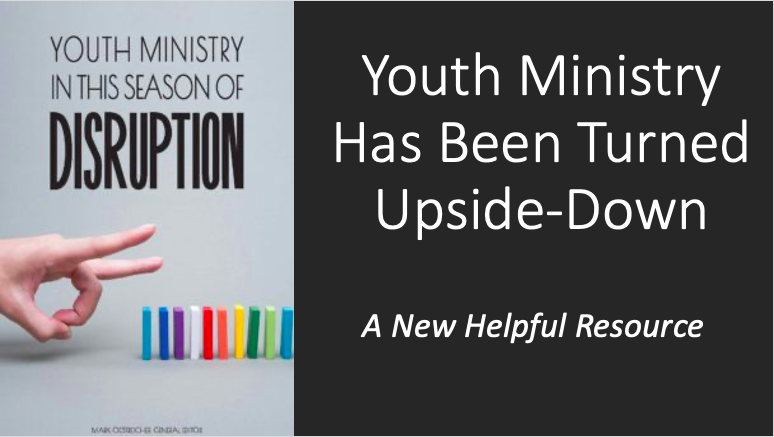My friend–and youth ministry veteran–Mark Oestreicher has compiled a new book, which is just out, called Youth Ministry in this Season of Disruption. I was privileged to write chapter 1: “Disruption Is Nothing New,” which gives a historical perspective on how the church has responded to a range of different kinds of disruptions throughout history. If you are a youth minister, or know someone who is, this book is a helpful and practical guide for doing youth ministry in our new day. Check out this quick interview with Marko:
SEAN MCDOWELL: What are some of the challenges youth pastors have faced since the arrival of COVID-19?
MARK OESTREICHER: In my 40 years of youth ministry, I’ve never seen a moment even close to this in terms of the collective discouragement—even lostness—of youth workers. I suggest in the intro of the book that I’ve seen 3 miniature stages, in terms of youth workers’ responses:
First, Action: mid-March to the end of April (mostly replicating previous programming online)
Second, Discouragement: late April through early August (almost universal sense that this isn't working, and we're not sure what to do)
Third, Innovation: early August into the fall (forced to attempt new things, with host-organization permission to risk, knowing that we couldn't go back to what we tried last Spring)
The current stage of innovation is bringing some hope and encouragement; but there’s still a ton of discouragement–there’s a gap between most youth workers’ calling and what they’re actually able to do.
MCDOWELL: What is the structure of the book and why did you arrange it that way?
OESTREICHER: I broke it into five sections, though the first two sections only have one chapter each. They are:
1. A Historical Encouragement (1 chapter – yours!)
2. A Theological Encouragement (1 chapter)
3. Issues to Think About (5 chapters)
4. Missteps and Learning (7 chapters)
5. What We’re Trying (13 chapters)
Honestly, I tried to keep that balance between what youth workers want (ideas) and what they need (encouragement).
And while I don’t want to over-spiritualize it, but the framing came to me one Tuesday morning fairly complete. And it felt very much like the Spirit’s leading. I had about 15 seconds of regret that we hadn’t started this two or three months earlier; but then I instantly sensed that it wouldn’t have been possible at that point, as we didn’t know enough, and most people weren’t really innovating at that point.
To be clear, though, this did mean going from concept to 28 contracted and assigned authors in 5 days, 1 more week for writing and a developmental edit, 1 week for a full edit, and 1 week for design and proofreading. I’m sure you realize, as someone who’s published many books, how stupid-fast that is!
MCDOWELL: Do you sense any changes in how youth ministry is done that will outlast COVID?
OESTREICHER: I hope so. But it’s not what we thought in the first month or so. Some of those technologies—Zoom, Instagram Live, YouTube Live, and others—are new tools in our kits, and they’ll be helpful; but mostly they’ll only be helpful as we move forward as reminders that we don’t need to be limited in our options; AND, that simply replicating programs in a new context (online, in this case) isn’t going to bring either satisfaction or lasting change.
Honestly, I think the biggest change is a sense of permission most youth workers are current feeling to try new things and accept failure as beneficial, or at least normal.
MCDOWELL: Can you give me a creative example of a youth pastor who adapted well?
OESTREICHER: Almost no one totally nailed it from day one – let’s be clear about that. They’re likely lying if they tell you otherwise. But, yeah, the best adaptations have been deeply contextual. They might not work in other contexts. Like the youth worker who worked with her worship service leadership to completely re-imagine their church services—including the sermon—to be truly interactive in an online setting, and truly all-ages (with an awesome highlight on the church’s teenagers).
And I think of the youth worker who, through a combination of luck, blessing and courage, used this season to completely reinvent her ministry with a focus on serving. These adaptations—those that were best—weren’t only something that worked for a season and will eventually get packed away for the next world crisis; these adaptions have permanently changed those ministries.
MCDOWELL: What are some positive trends that have emerged since COVID?
OESTREICHER: Ability to risk, as I’ve already mentioned. For many youth workers, I’ve seen how this season has brought a strong sense that they have to return to their values and build from there—and I’m a big fan of leading from values, not from goals. In fact, one of my favorite chapters in the book is in the Missteps & Learnings section: a youth worker wrote about how they did the big online move that everyone else tried, and they experienced the same slowly decreasing engagement that everyone experienced. Eventually, they realized they had to reinvent their success measurements, then build something new based on what they can do, rather than wasting time on what they can’t do.
Yeah, lots of reasons for hope, man! Hope starts (always, in the Bible, and in our lives) from places of longing!

